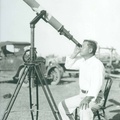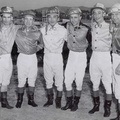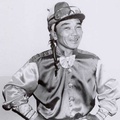Ask any Nisei from the south end of the Imperial Valley about their childhood Christmas experiences, and their fond reminiscences inevitably take them back to the Kokubuns’ church. Reverend Jingoro Kokubun was the pastor of two non-denominational Christian churches. In 1920, he founded both the Calexico Independent Church and Union Church in El Centro.
Rev. Kokubun hailed from the Tohoku region in northeastern Japan. He was born in Fukushima Prefecture. After completing elementary school, he was introduced to Christianity by a friend and was baptized in a local river. He graduated from Seigakuin Seminary in Tokyo and was assigned to a pastorate in Sendai, Miyagi Prefecture. In 1908 he immigrated to the United States. Twelve years later he and his wife, Iso, found themselves in the Imperial Valley. They lived in a modest adobe parsonage next to their church in Calexico.
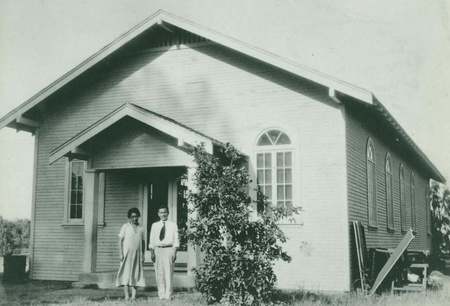
In his undated booklet called Japanese Christian Churches, Ben E. Watson praises the Kokubuns for the great strides they made in missionary work in Southern California. Rev. Kokubun was held in the highest esteem, not only among Nikkei families but within the Hakujin (white) community as well. According to Rafu Shimpo journalist Shiro Fujioka, Rev. Kokubun—who stood five feet one inch tall—was nicknamed “Little Great Man” by his Hakujin friends.
Beginning each Sunday morning, a service and Sunday School classes were conducted in Calexico. Then the entire Kokubun family would pile into their automobile for the twelve mile drive to El Centro where the services and Sunday School activities were repeated in the afternoon.
The holiday season was an especially busy time at the Kokubuns’ churches. Mrs. Kokubun organized annual Christmas pageants in which Nisei youths performed. Attending to the welfare of children had always been her special calling. Before marrying the pastor, Iso was a kindergarten teacher at the Osaka Christian Church. Upon arriving in the Imperial Valley she witnessed the appalling lack of childcare for farm families. Mrs. Kokubun promptly responded to the plight of the children by starting a nursery school in her home. It was so well received by the destitute farmers that when it initially opened Rev. Kokubun recalled the parsonage being overrun by over fifty Nisei children!

Each year just before Christmas, Rev. Kokubun would drive to Los Angeles to buy hundreds of toys for the children who attended the two Japanese language schools, which were sponsored by both of his churches. Many families were hard-pressed to give gifts, particularly during the Depression. The most cherished Christmas present that Kiyoshi “Kai” Kawanami received as a young boy was a toy boat that was powered by a candle. It was given to him by Rev. Kokubun. Even after more than fifty years had passed, Kai never forgot it.
New Year (Oshōgatsu) on the Ota Dairy
The New Year celebration was without question the most important holiday in Japanese immigrant communities. It was observed with the utmost solemnity, but at the same time it was a joyous and festive occasion. Underscoring the importance of Oshōgatsu, truck farmers typically abandoned their fields for several days prior to the first day of January and up to three days afterward. However, the New Year’s holiday was by no means a period of rest and relaxation.
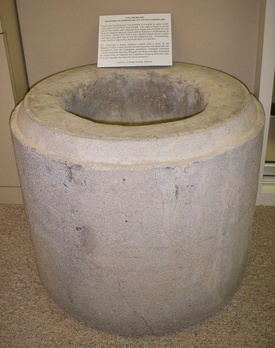
Oshōgatsu activities began with the making of mochi (rice cakes), traditionally done two days before January 1. Using wooden mallets or pestles (kine), cooked sweet rice was pounded into a sticky dough in a large mortar (usu). Authentic usu, made of granite or carved out of tree trunks, had been shipped from Japan to local Issei-owned stores, such as the Kamiya Company in El Centro’s Nihonmachi (Japantown). The usu were available for rent, but each store typically had only one so families had to queue up and wait their turn. Consequently, many families improvised with homemade usu molded out of concrete.
George Susumu Ota had grown up on a dairy farm in rural Calexico. His recollections paint a vivid picture of how Oshōgatsu was celebrated by the pioneer families before the Second World War:
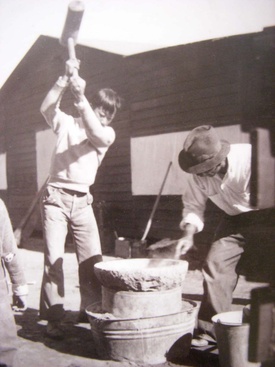 Mochitsuki (the making of mochi) on the Shimamoto farmstead in Imperial, California, 1936. Ed Shimamoto pounds the sweet rice with a kine as Seichi Mitamura flips the dough in a homemade usu. Courtesy of Japanese American Gallery, Imperial Valley Pioneers Museum.
Mochitsuki (the making of mochi) on the Shimamoto farmstead in Imperial, California, 1936. Ed Shimamoto pounds the sweet rice with a kine as Seichi Mitamura flips the dough in a homemade usu. Courtesy of Japanese American Gallery, Imperial Valley Pioneers Museum.On the mochitsuki day we had a makeshift fire outside where we steamed the sweet rice and we all took a turn in pounding the steamed rice placed in a wooden usu with a long handle wooden mallet. As we took turns pounding the rice, Grandmother would stir the rice in the [usu] so as the rice would be pounded into a smooth texture. Everyone pitched in to shape the mochi into a round form about three inches in diameter and an inch thick. Usually it took a good half a day to pound one hundred pounds of sweet rice.
Farmhouses in the Imperial Valley were not equipped with electricity until the late 1930s. In the absence of modern refrigeration, the Issei devised a rather peculiar method of storing mochi. The rice cakes were packed in lidded stoneware crock pots. The crockery was then submerged in water and kept that way. According to George, this process prevented the mochi from molding.
Issei women and their daughters prepared New Year delicacies called osechi ryōri. The cooking was painstaking work. It began days in advance and continued late into the night on New Year’s Eve. George reveals that even in the remote Imperial Valley, the immigrant generation managed to retain many of the traditional dishes, each of which was steeped in symbolism:
Prior to New Year’s Day, Mother would make the traditional osechi ryōri using canned foods imported from Japan such as takenoko (bamboo shoots), fuki (giant butterbur), kuromame (black beans), and kanten (gelatin). She made red and green yōkan (sweet bean jellied dessert) from the kanten. Some of the vegetables we grew on our dairy such as burdock (gobō), carrots, and renkon (lotus root) in our pound were also prepared. After all the cooking, she would arrange them into the ojūbako (decorative multi-tiered food box) together with broiled tai (sea bream), lobster, and shrimp. She also made kazunoko fish roe marinated in sake, sugar, and vinegar. Most of the Japanese foods were purchased at Mr. Okamura’s store in El Centro.
On New Year’s morning after the cows were milked and put out to pasture, we would all take a bath to cleanse our body to receive the New Year. Father would chant the Bukkyō sutra Juseige in front of our Obutsudan (Buddhist household altar). Mother was busy with sister May in making ozōni by placing two round mochi in each large soup bowl with some oysters and chopped greens. The broth was extracted from dried bonito shaving which was imported from Japan.
Throughout New Year’s Day we had close friends, relatives, and our church minister arrive for the New Year greetings. Mother would serve the prepared food and Father served the warm sake.
The Issei immigrant community throughout the Imperial Valley was eager to share the importance and festivity of Oshōgatsu with the mainstream Hakujin society. On January 6, 1915, a correspondent for the Brawley News reported that in the small town of Westmorland, a good way to the north of the Ota’s dairy, the “Japanese residents of our district celebrated, in their own social way, the opening of the New Year, and their American neighbors accepted invitations to partake in their genuine hospitality.”
© 2016 Tim Asamen


